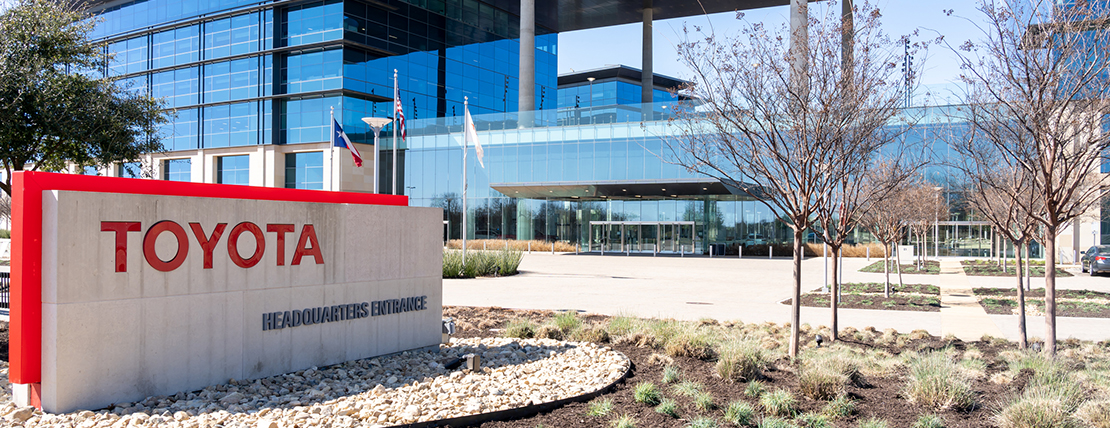Toyota Motor said on Wednesday it is raising the wages of nonunion U.S. factory workers, Reuters reports.
The announcement comes on the heels of the United Auto Workers union winning major pay and benefits hikes from Ford, General Motors and Stellantis.
Hourly manufacturing employees at top pay will receive a wage hike of about 9% effective on Jan. 1, 2024, the company confirmed. Other nonunion logistics and service parts employees are also getting pay increases.
"We value our employees and their contributions, and we show it by offering robust compensation packages that we continually review to ensure that we remain competitive within the automotive industry,” Chris Reynolds, Toyota Motor North America's executive vice president, said in a statement.
The pay of production Toyota workers in Kentucky at top scale will rise by $2.94 to $34.80 an hour, while the top pay of UAW workers at Ford will initially rise to $35.58 and hour from $32.05
Under the new tentative agreements with General Motors, Ford Motor and Stellantis, UAW workers will receive a wage hike of 11% upon ratification and 25% in wage hikes through April 2028. UAW workers will also be given cost-of-living adjustments. The amount of time needed for workers to hit top pay will decrease to three years from eight years.
GM Reaches Tentative Deal with UAW, Ending Auto Strikes
The United Auto Workers and General Motors on Monday agreed to a deal that will put an end to the bargaining between the union and Detroit automakers following more than six weeks of targeted U.S. labor strikes, CNBC reports.
GM is the final Detroit automaker to reach a deal with the union following historically contentious talks. Roughly a third of the union’s 146,000 workers with GM, Ford Motor and Stellantis went on strike after the sides failed to reach agreements by a Sept. 14 deadline.
The UAW said the tentative agreement, which still must be ratified by members, adds battery workers from GM’s Ultium Cells joint venture and a division known as “subsystems” into the union’s master agreement with the company.
“Like the agreements with Ford and Stellantis, the GM agreement has turned record profits into a record contract,” the UAW said in a release. “The deal includes gains valued at more than four times the gains from the union’s 2019 contract.”
The four-and-a-half year tentative agreements must still be ratified by members at each of the automakers. The headline economics of the deals, such as 25% wage increases for most workers, were patterned off Ford’s initial deal.
The pact includes 25% pay increases over the terms of the agreement. The raises and benefits such as cost-of-living adjustments cumulatively raise the top wage to more than $42 an hour, including an increase of 70% for starting wages to over $30 an hour, the union said. That increase would be at least two percentage points higher than the Ford and Stellantis deals.
Adidas, Home Depot Sued Over Job Posting Pay Transparency
A batch of proposed class action lawsuits have been filed in Washington state against major companies such as Adidas, Home Depot and Marriott International over a failure to advertise pay ranges and benefits information as required by the state law that went into effect Jan. 1, Bloomberg Law reports.
Each case could cover hundreds of job applicants, according to the complaints. The salary requirements, which are also in effect in California, Colorado and New York, represent a watershed moment in the pay transparency movement, as the rulings will set a standard for how employers could be punished for failure to comply with pay transparency law requirements, Bloomberg Law notes.
Beyond the potential pay equity benefits, the new mandates pose a litigation threat for businesses advertising jobs that can be performed in California and Washington, where the laws include a private right of action with a minimum damages award of $5,000 per person in the Washington statute.
Most of those Washington cases have been filed in state court within the past month, so it’s too early to know how judges will treat their claims. Seattle plaintiff’s firm Emery Reddy PLLC has filed most if not all of those cases in King County Superior Court.
Key legal questions will include whether the job applicants can show they suffered any injury to merit an award of damages simply by seeing a job ad without a salary range and clicking “submit” on an application, said Missy Mordy, an employment lawyer with Davis Wright Tremaine LLP in Bellevue, Washington.
“One of the things we’re curious about is whether the plaintiffs have standing to bring the lawsuits,” she said. The Washington law arguably requires that a person be qualified and legitimately applying for a job, not just trolling the internet for noncompliant job listings, she added.
The litigation risk for employers, as well as the payoff potential for plaintiffs and their attorneys, also will depend on whether the courts affirm class status. The Washington complaints claim to cover dozens or hundreds of class members each, including anyone who applied for the jobs posted without salary ranges.
“These are absolutely test cases,” Mordy said.
U.S. Economy Adds 150,000 Jobs in October
The U.S. economy saw job creation decelerate in October, as 150,000 jobs were added for the month, according to the Department of Labor’s jobs report.
The job gains fell short of the 170,000 figure economists had projected. The unemployment rate rose to 3.9%, the highest level since January 2022. Employment as measured in the household survey, which is used to compute the unemployment rate, showed a decline of 348,000 workers, while the rolls of unemployed rose by 146,000.
A more encompassing jobless rate that includes discouraged workers and those holding part-time positions for economic reasons rose to 7.2%, an increase of 0.2 percentage point. The labor force participation rate declined slightly to 62.7%, while the labor force contracted by 201,000.
“Winter cooling is hitting the labor market,” said Becky Frankiewicz, chief commercial officer at staffing firm ManpowerGroup told CNBC. “The post-pandemic hiring frenzy and summer hiring warmth has cooled and companies are now holding onto employees.”
Average hourly earnings, a key measure for inflation, increased 0.2% for the month, less than the 0.3% forecast, while the 4.1% year-over-year gain was 0.1 percentage point above expectations. The average work week nudged lower to 34.3 hours.
Editor's Note: Additional Content
For more information and resources related to this article see the pages below, which offer quick access to all WorldatWork content on these topics:







